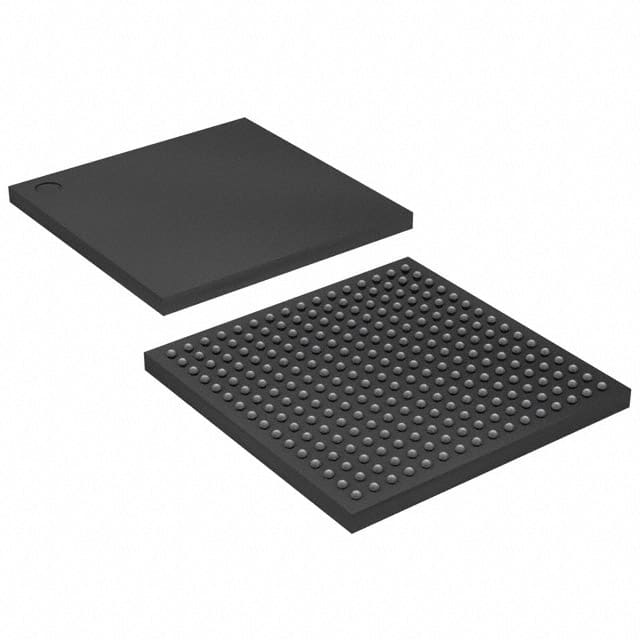Consulte las especificaciones para obtener detalles del producto.

EP4CE15M9C7N
Product Overview
- Category: Programmable Logic Device (PLD)
- Use: EP4CE15M9C7N is a PLD used for digital logic design and implementation.
- Characteristics:
- High-performance device with low power consumption
- Offers high-speed data processing capabilities
- Provides flexibility in designing complex digital systems
- Package: The EP4CE15M9C7N comes in a compact package suitable for surface mount technology (SMT) applications.
- Essence: EP4CE15M9C7N is an essential component for building advanced digital systems.
- Packaging/Quantity: Typically packaged in reels or trays, the quantity may vary depending on the supplier.
Specifications
- Logic Elements: 15,183
- Memory Bits: 608,256
- Embedded Multipliers: 56
- Maximum User I/O Pins: 179
- Operating Voltage: 1.2V
- Speed Grade: 7
- Package Type: FBGA (Fine-pitch Ball Grid Array)
- Package Size: 144-ball
- Temperature Range: Commercial (0°C to 85°C)
Detailed Pin Configuration
The EP4CE15M9C7N has a total of 179 user I/O pins, which are configurable for various purposes. These pins are organized into different banks, each serving specific functions such as input, output, or bidirectional communication. The pin configuration can be found in the device datasheet provided by the manufacturer.
Functional Features
- High-speed performance: EP4CE15M9C7N offers fast data processing capabilities, making it suitable for applications requiring real-time operations.
- Flexibility: The device allows for easy reconfiguration, enabling designers to modify the functionality of the digital system without changing the hardware.
- Low power consumption: EP4CE15M9C7N is designed to minimize power consumption, making it suitable for battery-powered applications.
- Embedded Multipliers: The device includes embedded multipliers that facilitate efficient implementation of arithmetic operations.
Advantages and Disadvantages
Advantages: - High-performance capabilities - Flexibility in design - Low power consumption - Embedded multipliers for efficient arithmetic operations
Disadvantages: - Limited number of user I/O pins - Complexity in programming and configuration
Working Principles
EP4CE15M9C7N is based on the field-programmable gate array (FPGA) technology. It consists of configurable logic blocks (CLBs), interconnect resources, and embedded components such as memory blocks and multipliers. The device can be programmed using hardware description languages (HDLs) or graphical tools provided by the manufacturer. Once programmed, the EP4CE15M9C7N executes the desired digital logic functions.
Detailed Application Field Plans
The EP4CE15M9C7N finds applications in various fields, including:
- Communications: Used in wireless communication systems for signal processing and modulation/demodulation tasks.
- Industrial Automation: Employed in control systems for real-time monitoring and control of industrial processes.
- Automotive: Integrated into automotive electronics for functions like engine control, advanced driver assistance systems (ADAS), and infotainment systems.
- Consumer Electronics: Utilized in devices like smartphones, tablets, and gaming consoles for high-speed data processing and multimedia applications.
- Medical Devices: Incorporated into medical equipment for data acquisition, signal processing, and control functions.
Detailed and Complete Alternative Models
- EP4CE10F17C8N: A lower-cost alternative with similar features but reduced logic elements and memory bits.
- EP4CE30F23C6N: A higher-capacity alternative with increased logic elements and memory bits, suitable for more complex designs.
- EP4CE115F29C7N: A higher-performance alternative with additional embedded multipliers, ideal for applications requiring extensive arithmetic operations.
Note: The above alternatives are just a few examples, and there are many other models available in the same product family that cater to different design requirements.
Word count: 536 words
Enumere 10 preguntas y respuestas comunes relacionadas con la aplicación de EP4CE15M9C7N en soluciones técnicas
Sure! Here are 10 common questions and answers related to the application of EP4CE15M9C7N in technical solutions:
Q: What is EP4CE15M9C7N? A: EP4CE15M9C7N is a field-programmable gate array (FPGA) chip manufactured by Intel (formerly Altera). It offers programmable logic, digital signal processing (DSP), and high-speed I/O capabilities.
Q: What are the key features of EP4CE15M9C7N? A: Some key features include 15,408 logic elements, 414,720 bits of embedded memory, 270 DSP blocks, and support for various I/O standards like LVDS, SSTL, and HSTL.
Q: What are the typical applications of EP4CE15M9C7N? A: EP4CE15M9C7N can be used in a wide range of applications such as industrial automation, telecommunications, automotive systems, medical devices, video processing, and more.
Q: How do I program EP4CE15M9C7N? A: EP4CE15M9C7N can be programmed using hardware description languages (HDLs) like VHDL or Verilog, and the Quartus Prime software provided by Intel.
Q: Can EP4CE15M9C7N be reprogrammed after deployment? A: Yes, EP4CE15M9C7N is a reprogrammable FPGA, allowing you to modify its functionality even after it has been deployed in a system.
Q: What kind of power supply does EP4CE15M9C7N require? A: EP4CE15M9C7N typically requires a single 3.3V power supply, although it also supports other voltage levels for specific I/O standards.
Q: Does EP4CE15M9C7N have built-in communication interfaces? A: Yes, EP4CE15M9C7N supports various communication interfaces such as UART, SPI, I2C, and Ethernet, which can be implemented using its programmable logic resources.
Q: Can EP4CE15M9C7N interface with external memory devices? A: Yes, EP4CE15M9C7N has dedicated pins and embedded memory blocks that allow it to interface with external memory devices like DDR SDRAM or Flash memory.
Q: What is the maximum operating frequency of EP4CE15M9C7N? A: The maximum operating frequency of EP4CE15M9C7N depends on the design and implementation, but it can typically reach frequencies in the range of hundreds of megahertz (MHz) or even gigahertz (GHz).
Q: Are there any development boards available for EP4CE15M9C7N? A: Yes, Intel provides development boards like the DE0-Nano board, which feature EP4CE15M9C7N, allowing you to prototype and test your designs before integrating them into your final solution.
I hope these questions and answers provide you with useful information about EP4CE15M9C7N and its applications in technical solutions!

